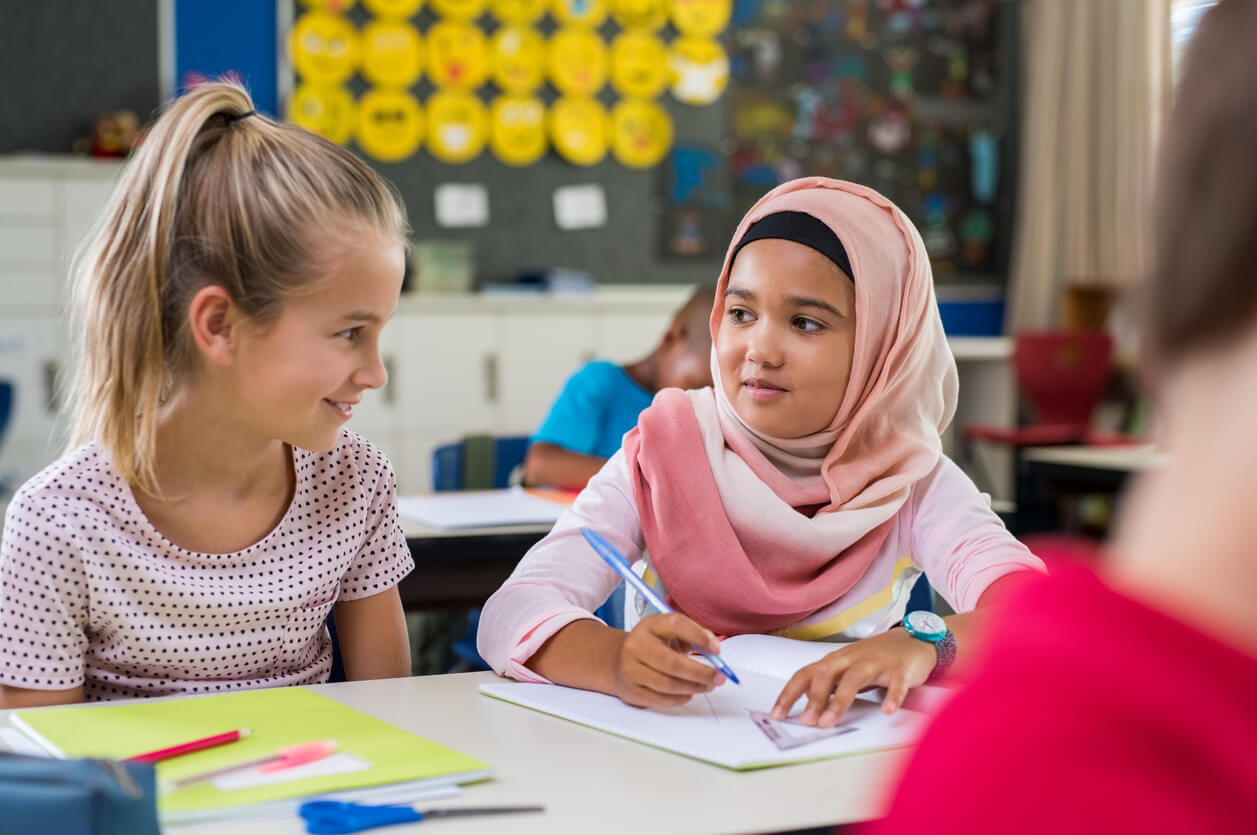4 Educational Trends for the Future


Written and verified by the neuroeducator Nadia Yépez Suarez
What are the 4 educational trends for the future that your children will need in order to thrive? As parents, when we ask ourselves about the future of our children, we usually relate it to school. For this reason, below, we’ll tell you which educational trends are observed and are based on some common aspects.
1. Social skills
Learning to live together implies having developed social skills that allow them to relate properly in groups, whether it’s within the family, at school, or at work. It’s important to know them and develop them from an early age to be able to work in a team, express opinions, thoughts, or desires, and respect healthy coexistence.
Since the time of the caves, the human being has developed in search of common welfare and collaborated in social actions. The relationship with others is the success for us to survive, so it is important to learn these skills. The more we practice them, the better we will feel.

2. Emotions
It’s important that we help our children, from an early age, to identify their emotions so that they can regulate them. These emotions are part of our daily life, so they define our decision-making, our relationship with others, and how we act in particular. In this way, our children will be in better conditions to face challenges and tolerate frustrations.
We can remember a situation in which we had control of our emotions and our reaction allowed us to make the best decision. However, there were also others in which impulse won out and the results weren’t the best. The neuroscientist Eduard Punset reminds us that between the ages of 4 and 10, we must activate children’s emotions so that they have the necessary intellectual curiosity. But how can we do this if we don’t recognize emotions?
It’s best to start by identifying joy and what activities or situations in daily life make us feel happy. Neurosciences have shown us that we should talk about an affective and cognitive brain. This is because, thanks to scientific advances, we can affirm that emotions play a fundamental role in our lives and especially in learning.
3. Creativity and imagination
According to Fuentes and Torbay (2004), creativity is indispensable for personal development, as well as for professional training and success. It is complemented by the recognition that, in these times when everything is changing so rapidly, creativity is fundamental for the development of the person by favoring his or her capacity to respond to individual and social needs.
In these times, creative and imaginative people are required, who can devise elements, tools, and processes to solve collective problems or needs. To this end, they must be more open to the new in favor of the society in which they develop.
Creativity is, for neurosciences, the superior capacity that promotes, creates, and preserves culture. It also allows the transformation of the environment with flexible and integrative thinking. In addition, it implies the highest cognitive process, as it requires information, reasoning, resolution, and others to be considered in order to create something new and different.

4. Use of technologies
The technological revolution we’re experiencing has allowed us to call children “digital natives“. This means that they were born into a world in which we’re connected to perform tasks that we hadn’t imagined before. That is, we use different technological devices to make bank transfers, online shopping, communications, studies, medical consultations, or work from home, among others.
Teaching and learning in a personalized way
These educational trends for the future may help, both within the family and at school, to work on the formation of the emotional, personal, and social well-being of children. It’s important to teach and learn in a personalized way, respecting the child’s own pace and promoting their own abilities. It’s also important to promote intelligent classrooms or spaces that favor the use of technology.
The sooner you help your child, the sooner you can promote dialogue, trust, freedom, and love in your home, as well as identify a school that favors these educational trends for the future. Finally, remember that all of these social environments require an emotional, social, creative, and cognitive brain.
What are the 4 educational trends for the future that your children will need in order to thrive? As parents, when we ask ourselves about the future of our children, we usually relate it to school. For this reason, below, we’ll tell you which educational trends are observed and are based on some common aspects.
1. Social skills
Learning to live together implies having developed social skills that allow them to relate properly in groups, whether it’s within the family, at school, or at work. It’s important to know them and develop them from an early age to be able to work in a team, express opinions, thoughts, or desires, and respect healthy coexistence.
Since the time of the caves, the human being has developed in search of common welfare and collaborated in social actions. The relationship with others is the success for us to survive, so it is important to learn these skills. The more we practice them, the better we will feel.

2. Emotions
It’s important that we help our children, from an early age, to identify their emotions so that they can regulate them. These emotions are part of our daily life, so they define our decision-making, our relationship with others, and how we act in particular. In this way, our children will be in better conditions to face challenges and tolerate frustrations.
We can remember a situation in which we had control of our emotions and our reaction allowed us to make the best decision. However, there were also others in which impulse won out and the results weren’t the best. The neuroscientist Eduard Punset reminds us that between the ages of 4 and 10, we must activate children’s emotions so that they have the necessary intellectual curiosity. But how can we do this if we don’t recognize emotions?
It’s best to start by identifying joy and what activities or situations in daily life make us feel happy. Neurosciences have shown us that we should talk about an affective and cognitive brain. This is because, thanks to scientific advances, we can affirm that emotions play a fundamental role in our lives and especially in learning.
3. Creativity and imagination
According to Fuentes and Torbay (2004), creativity is indispensable for personal development, as well as for professional training and success. It is complemented by the recognition that, in these times when everything is changing so rapidly, creativity is fundamental for the development of the person by favoring his or her capacity to respond to individual and social needs.
In these times, creative and imaginative people are required, who can devise elements, tools, and processes to solve collective problems or needs. To this end, they must be more open to the new in favor of the society in which they develop.
Creativity is, for neurosciences, the superior capacity that promotes, creates, and preserves culture. It also allows the transformation of the environment with flexible and integrative thinking. In addition, it implies the highest cognitive process, as it requires information, reasoning, resolution, and others to be considered in order to create something new and different.

4. Use of technologies
The technological revolution we’re experiencing has allowed us to call children “digital natives“. This means that they were born into a world in which we’re connected to perform tasks that we hadn’t imagined before. That is, we use different technological devices to make bank transfers, online shopping, communications, studies, medical consultations, or work from home, among others.
Teaching and learning in a personalized way
These educational trends for the future may help, both within the family and at school, to work on the formation of the emotional, personal, and social well-being of children. It’s important to teach and learn in a personalized way, respecting the child’s own pace and promoting their own abilities. It’s also important to promote intelligent classrooms or spaces that favor the use of technology.
The sooner you help your child, the sooner you can promote dialogue, trust, freedom, and love in your home, as well as identify a school that favors these educational trends for the future. Finally, remember that all of these social environments require an emotional, social, creative, and cognitive brain.
All cited sources were thoroughly reviewed by our team to ensure their quality, reliability, currency, and validity. The bibliography of this article was considered reliable and of academic or scientific accuracy.
- Bisquerra, R.; Punset, E.; Mora, F.; y otros. 2021. ¿Cómo educar las emociones? La inteligencia emocional en la infancia y la adolescencia. Esplugues de Llobregat (Barcelona): Hospital Sant Joan de Déu.
- Franco Justo, C., & Justo Martínez, E. (2009). Efectos de un programa de intervención basado en la imaginación, la relajación y el cuento infantil, sobre los niveles de creatividad verbal, gráfica y motora en un grupo de niños de último curso de educación infantil. Revista Iberoamericana De Educación, 49(3), 1-11.
This text is provided for informational purposes only and does not replace consultation with a professional. If in doubt, consult your specialist.








